Leadership Management Essay: Challenges of Leadership Today
VerifiedAdded on 2022/12/26
|9
|2077
|52
Essay
AI Summary
This essay examines the multifaceted challenges confronting modern-day leaders, emphasizing the complexities of navigating a dynamic and globalized environment. It explores the need for leaders to motivate diverse teams, improve organizational efficiency, and meet the expectations of various stakeholders. The essay delves into cultural considerations, digital disruption, and increased competition as significant challenges. It recommends developing robust leadership programs tailored to corporate culture, emphasizing multi-media training, clear goals, and practical knowledge to enhance leadership skills. Furthermore, it addresses the limitations of traditional leadership approaches, advocating for transformational, authentic, and inclusive leadership styles. The analysis highlights the importance of adapting to the evolving needs of employees and the organization to foster innovation and achieve common goals. Finally, the essay concludes by underscoring the importance of adopting certain personality characteristics and modern leadership principles to excel in the current era.
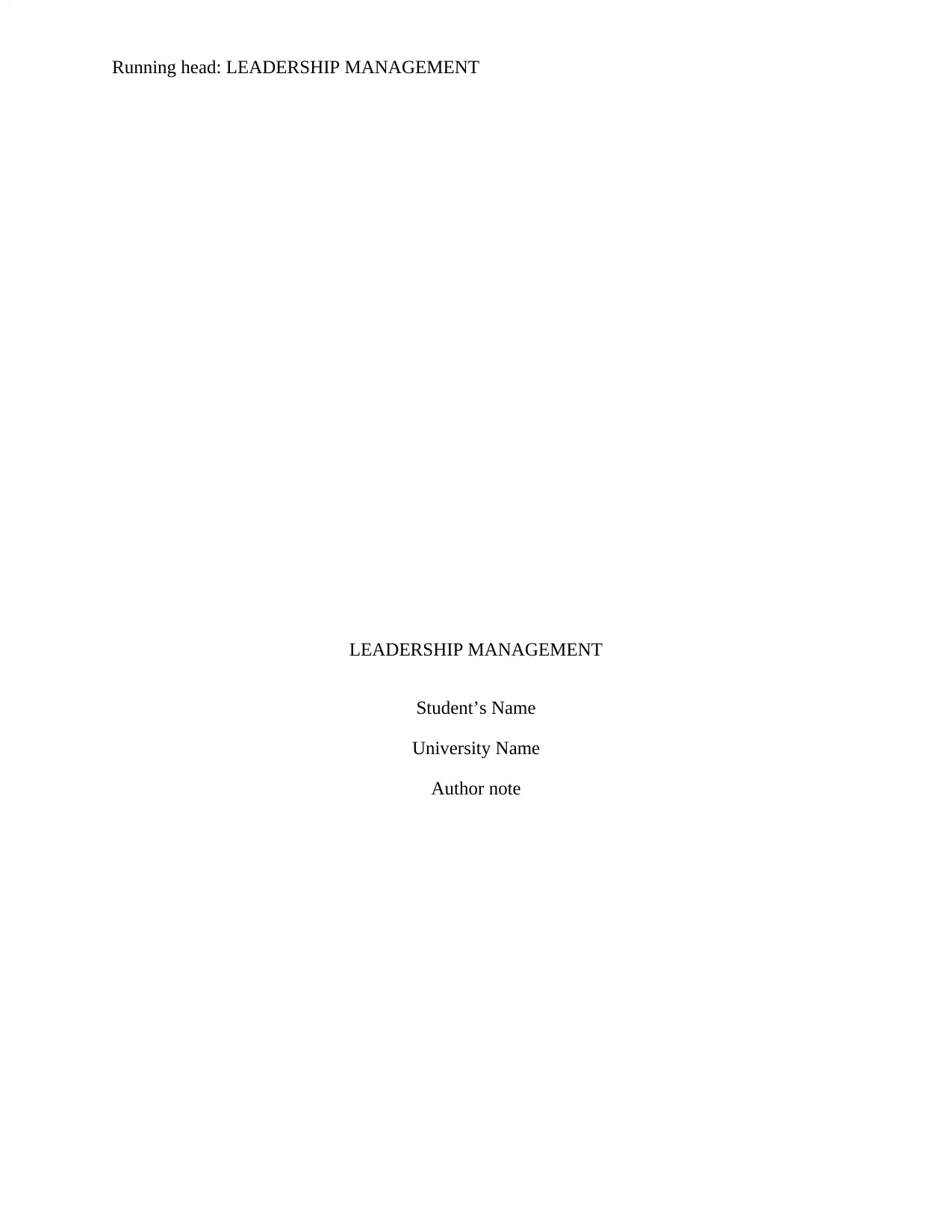
Running head: LEADERSHIP MANAGEMENT
LEADERSHIP MANAGEMENT
Student’s Name
University Name
Author note
LEADERSHIP MANAGEMENT
Student’s Name
University Name
Author note
Paraphrase This Document
Need a fresh take? Get an instant paraphrase of this document with our AI Paraphraser
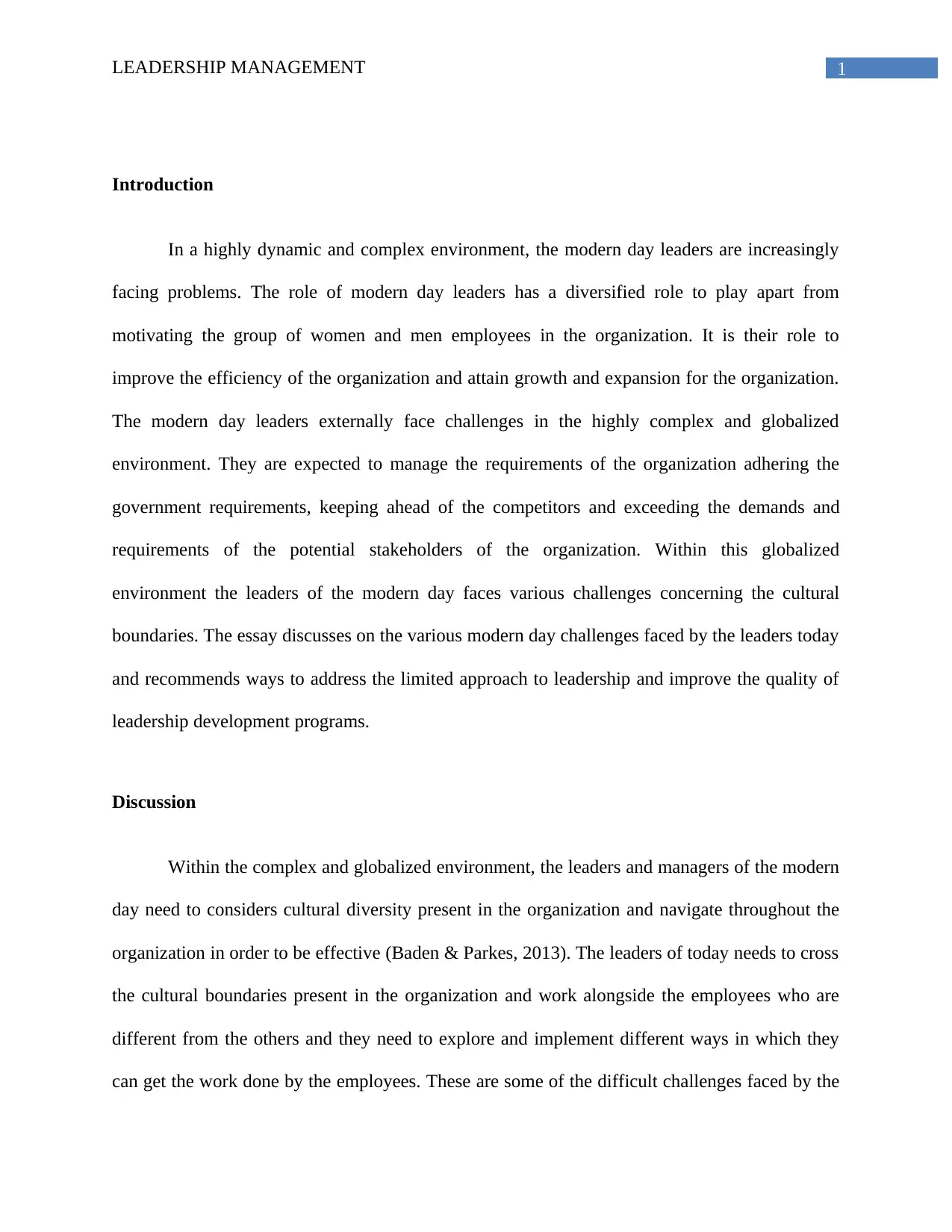
1LEADERSHIP MANAGEMENT
Introduction
In a highly dynamic and complex environment, the modern day leaders are increasingly
facing problems. The role of modern day leaders has a diversified role to play apart from
motivating the group of women and men employees in the organization. It is their role to
improve the efficiency of the organization and attain growth and expansion for the organization.
The modern day leaders externally face challenges in the highly complex and globalized
environment. They are expected to manage the requirements of the organization adhering the
government requirements, keeping ahead of the competitors and exceeding the demands and
requirements of the potential stakeholders of the organization. Within this globalized
environment the leaders of the modern day faces various challenges concerning the cultural
boundaries. The essay discusses on the various modern day challenges faced by the leaders today
and recommends ways to address the limited approach to leadership and improve the quality of
leadership development programs.
Discussion
Within the complex and globalized environment, the leaders and managers of the modern
day need to considers cultural diversity present in the organization and navigate throughout the
organization in order to be effective (Baden & Parkes, 2013). The leaders of today needs to cross
the cultural boundaries present in the organization and work alongside the employees who are
different from the others and they need to explore and implement different ways in which they
can get the work done by the employees. These are some of the difficult challenges faced by the
Introduction
In a highly dynamic and complex environment, the modern day leaders are increasingly
facing problems. The role of modern day leaders has a diversified role to play apart from
motivating the group of women and men employees in the organization. It is their role to
improve the efficiency of the organization and attain growth and expansion for the organization.
The modern day leaders externally face challenges in the highly complex and globalized
environment. They are expected to manage the requirements of the organization adhering the
government requirements, keeping ahead of the competitors and exceeding the demands and
requirements of the potential stakeholders of the organization. Within this globalized
environment the leaders of the modern day faces various challenges concerning the cultural
boundaries. The essay discusses on the various modern day challenges faced by the leaders today
and recommends ways to address the limited approach to leadership and improve the quality of
leadership development programs.
Discussion
Within the complex and globalized environment, the leaders and managers of the modern
day need to considers cultural diversity present in the organization and navigate throughout the
organization in order to be effective (Baden & Parkes, 2013). The leaders of today needs to cross
the cultural boundaries present in the organization and work alongside the employees who are
different from the others and they need to explore and implement different ways in which they
can get the work done by the employees. These are some of the difficult challenges faced by the
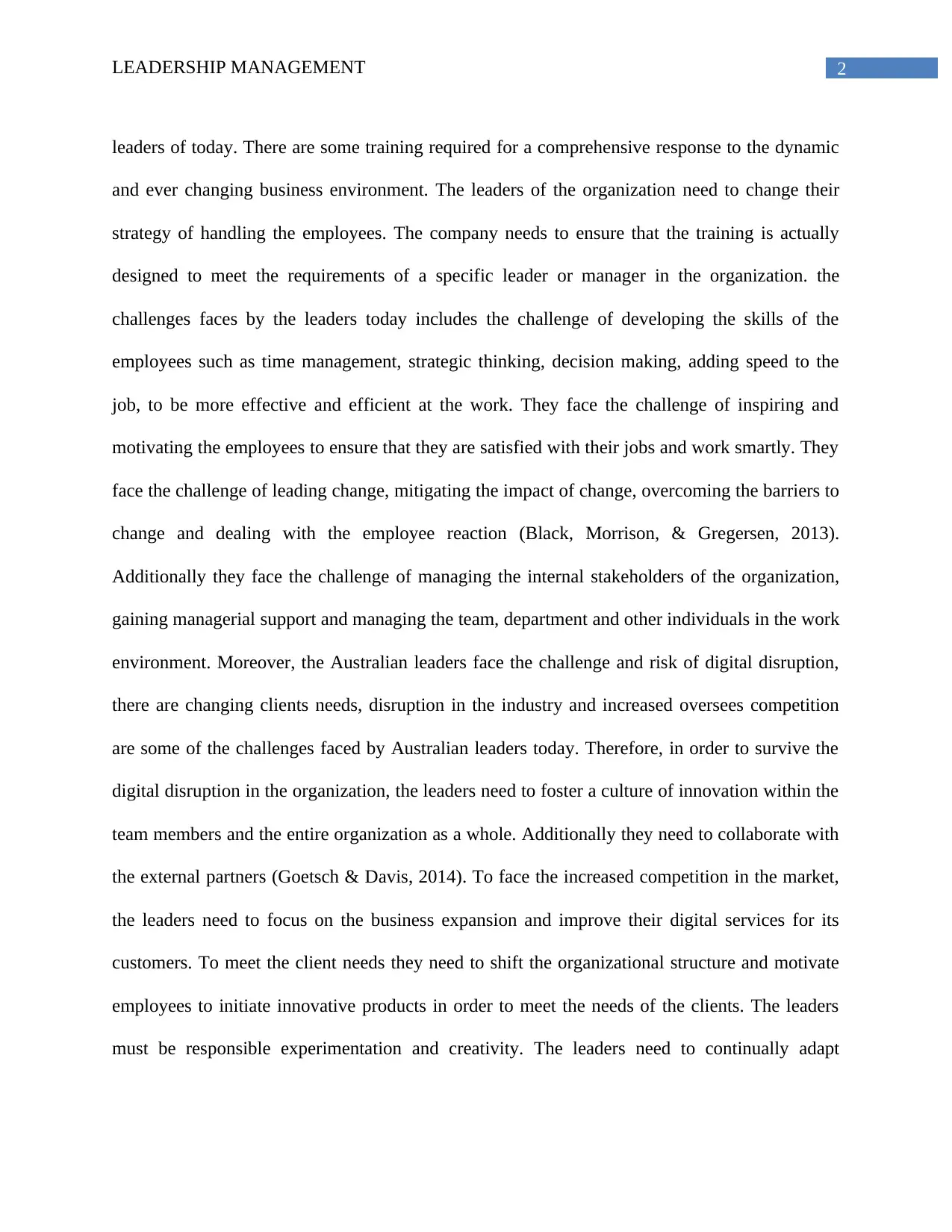
2LEADERSHIP MANAGEMENT
leaders of today. There are some training required for a comprehensive response to the dynamic
and ever changing business environment. The leaders of the organization need to change their
strategy of handling the employees. The company needs to ensure that the training is actually
designed to meet the requirements of a specific leader or manager in the organization. the
challenges faces by the leaders today includes the challenge of developing the skills of the
employees such as time management, strategic thinking, decision making, adding speed to the
job, to be more effective and efficient at the work. They face the challenge of inspiring and
motivating the employees to ensure that they are satisfied with their jobs and work smartly. They
face the challenge of leading change, mitigating the impact of change, overcoming the barriers to
change and dealing with the employee reaction (Black, Morrison, & Gregersen, 2013).
Additionally they face the challenge of managing the internal stakeholders of the organization,
gaining managerial support and managing the team, department and other individuals in the work
environment. Moreover, the Australian leaders face the challenge and risk of digital disruption,
there are changing clients needs, disruption in the industry and increased oversees competition
are some of the challenges faced by Australian leaders today. Therefore, in order to survive the
digital disruption in the organization, the leaders need to foster a culture of innovation within the
team members and the entire organization as a whole. Additionally they need to collaborate with
the external partners (Goetsch & Davis, 2014). To face the increased competition in the market,
the leaders need to focus on the business expansion and improve their digital services for its
customers. To meet the client needs they need to shift the organizational structure and motivate
employees to initiate innovative products in order to meet the needs of the clients. The leaders
must be responsible experimentation and creativity. The leaders need to continually adapt
leaders of today. There are some training required for a comprehensive response to the dynamic
and ever changing business environment. The leaders of the organization need to change their
strategy of handling the employees. The company needs to ensure that the training is actually
designed to meet the requirements of a specific leader or manager in the organization. the
challenges faces by the leaders today includes the challenge of developing the skills of the
employees such as time management, strategic thinking, decision making, adding speed to the
job, to be more effective and efficient at the work. They face the challenge of inspiring and
motivating the employees to ensure that they are satisfied with their jobs and work smartly. They
face the challenge of leading change, mitigating the impact of change, overcoming the barriers to
change and dealing with the employee reaction (Black, Morrison, & Gregersen, 2013).
Additionally they face the challenge of managing the internal stakeholders of the organization,
gaining managerial support and managing the team, department and other individuals in the work
environment. Moreover, the Australian leaders face the challenge and risk of digital disruption,
there are changing clients needs, disruption in the industry and increased oversees competition
are some of the challenges faced by Australian leaders today. Therefore, in order to survive the
digital disruption in the organization, the leaders need to foster a culture of innovation within the
team members and the entire organization as a whole. Additionally they need to collaborate with
the external partners (Goetsch & Davis, 2014). To face the increased competition in the market,
the leaders need to focus on the business expansion and improve their digital services for its
customers. To meet the client needs they need to shift the organizational structure and motivate
employees to initiate innovative products in order to meet the needs of the clients. The leaders
must be responsible experimentation and creativity. The leaders need to continually adapt
⊘ This is a preview!⊘
Do you want full access?
Subscribe today to unlock all pages.

Trusted by 1+ million students worldwide
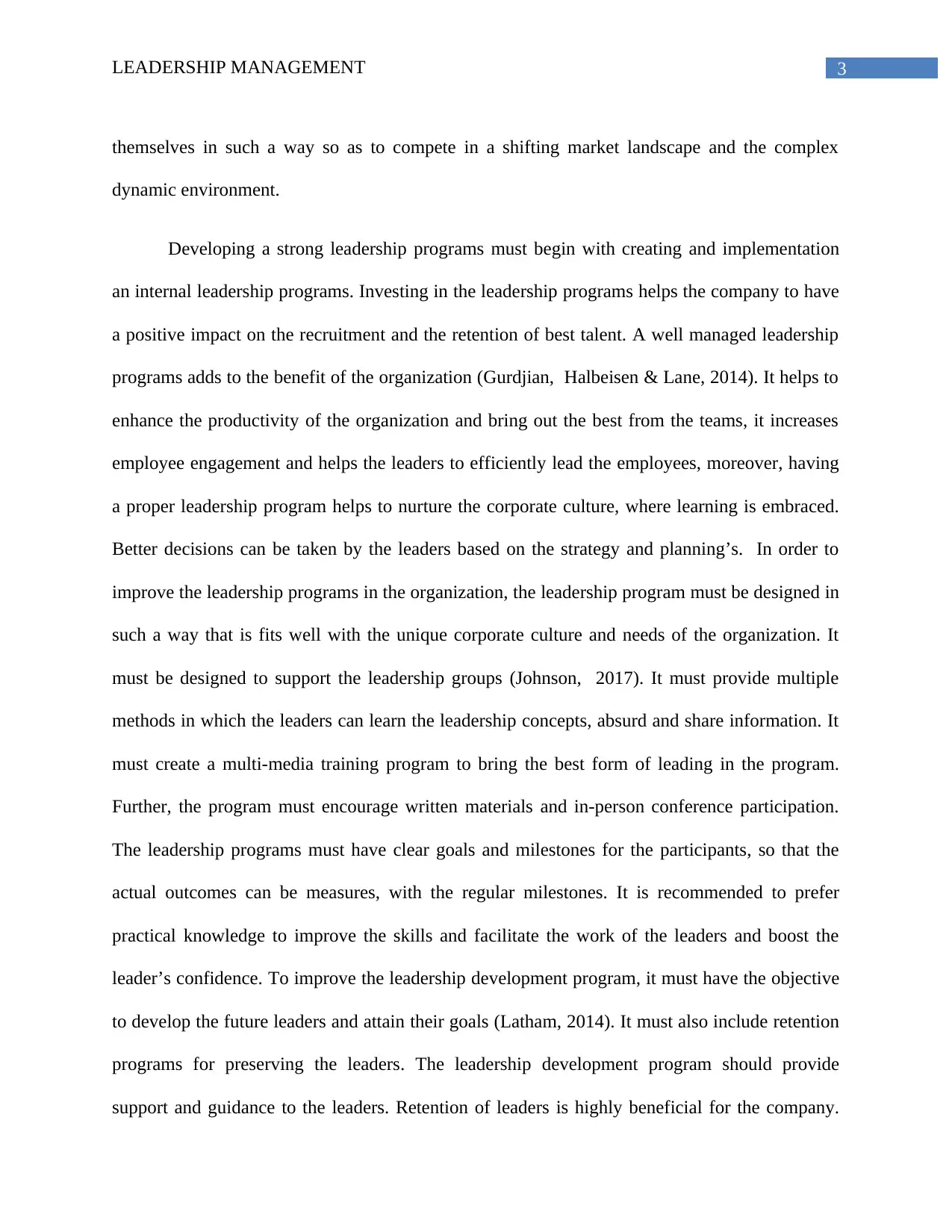
3LEADERSHIP MANAGEMENT
themselves in such a way so as to compete in a shifting market landscape and the complex
dynamic environment.
Developing a strong leadership programs must begin with creating and implementation
an internal leadership programs. Investing in the leadership programs helps the company to have
a positive impact on the recruitment and the retention of best talent. A well managed leadership
programs adds to the benefit of the organization (Gurdjian, Halbeisen & Lane, 2014). It helps to
enhance the productivity of the organization and bring out the best from the teams, it increases
employee engagement and helps the leaders to efficiently lead the employees, moreover, having
a proper leadership program helps to nurture the corporate culture, where learning is embraced.
Better decisions can be taken by the leaders based on the strategy and planning’s. In order to
improve the leadership programs in the organization, the leadership program must be designed in
such a way that is fits well with the unique corporate culture and needs of the organization. It
must be designed to support the leadership groups (Johnson, 2017). It must provide multiple
methods in which the leaders can learn the leadership concepts, absurd and share information. It
must create a multi-media training program to bring the best form of leading in the program.
Further, the program must encourage written materials and in-person conference participation.
The leadership programs must have clear goals and milestones for the participants, so that the
actual outcomes can be measures, with the regular milestones. It is recommended to prefer
practical knowledge to improve the skills and facilitate the work of the leaders and boost the
leader’s confidence. To improve the leadership development program, it must have the objective
to develop the future leaders and attain their goals (Latham, 2014). It must also include retention
programs for preserving the leaders. The leadership development program should provide
support and guidance to the leaders. Retention of leaders is highly beneficial for the company.
themselves in such a way so as to compete in a shifting market landscape and the complex
dynamic environment.
Developing a strong leadership programs must begin with creating and implementation
an internal leadership programs. Investing in the leadership programs helps the company to have
a positive impact on the recruitment and the retention of best talent. A well managed leadership
programs adds to the benefit of the organization (Gurdjian, Halbeisen & Lane, 2014). It helps to
enhance the productivity of the organization and bring out the best from the teams, it increases
employee engagement and helps the leaders to efficiently lead the employees, moreover, having
a proper leadership program helps to nurture the corporate culture, where learning is embraced.
Better decisions can be taken by the leaders based on the strategy and planning’s. In order to
improve the leadership programs in the organization, the leadership program must be designed in
such a way that is fits well with the unique corporate culture and needs of the organization. It
must be designed to support the leadership groups (Johnson, 2017). It must provide multiple
methods in which the leaders can learn the leadership concepts, absurd and share information. It
must create a multi-media training program to bring the best form of leading in the program.
Further, the program must encourage written materials and in-person conference participation.
The leadership programs must have clear goals and milestones for the participants, so that the
actual outcomes can be measures, with the regular milestones. It is recommended to prefer
practical knowledge to improve the skills and facilitate the work of the leaders and boost the
leader’s confidence. To improve the leadership development program, it must have the objective
to develop the future leaders and attain their goals (Latham, 2014). It must also include retention
programs for preserving the leaders. The leadership development program should provide
support and guidance to the leaders. Retention of leaders is highly beneficial for the company.
Paraphrase This Document
Need a fresh take? Get an instant paraphrase of this document with our AI Paraphraser
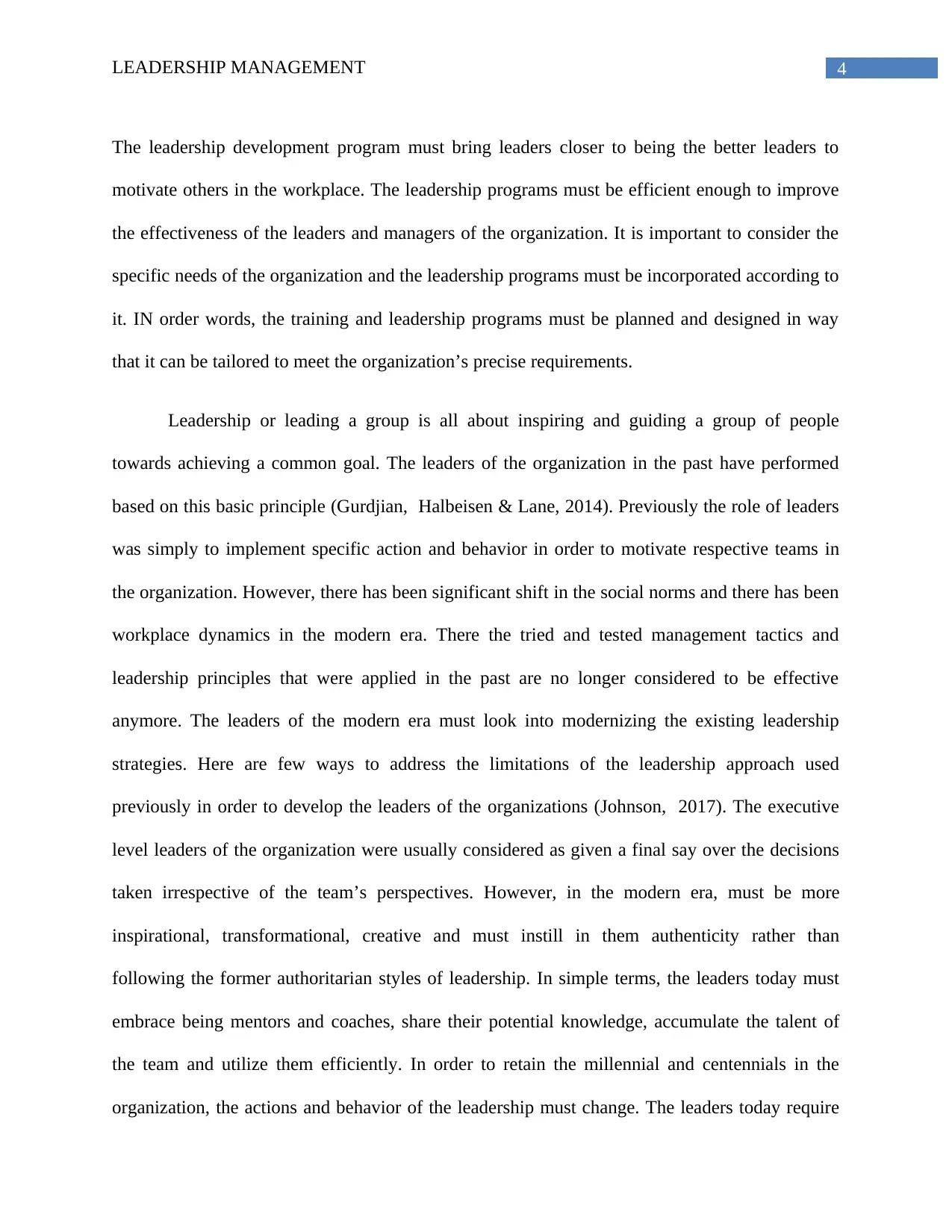
4LEADERSHIP MANAGEMENT
The leadership development program must bring leaders closer to being the better leaders to
motivate others in the workplace. The leadership programs must be efficient enough to improve
the effectiveness of the leaders and managers of the organization. It is important to consider the
specific needs of the organization and the leadership programs must be incorporated according to
it. IN order words, the training and leadership programs must be planned and designed in way
that it can be tailored to meet the organization’s precise requirements.
Leadership or leading a group is all about inspiring and guiding a group of people
towards achieving a common goal. The leaders of the organization in the past have performed
based on this basic principle (Gurdjian, Halbeisen & Lane, 2014). Previously the role of leaders
was simply to implement specific action and behavior in order to motivate respective teams in
the organization. However, there has been significant shift in the social norms and there has been
workplace dynamics in the modern era. There the tried and tested management tactics and
leadership principles that were applied in the past are no longer considered to be effective
anymore. The leaders of the modern era must look into modernizing the existing leadership
strategies. Here are few ways to address the limitations of the leadership approach used
previously in order to develop the leaders of the organizations (Johnson, 2017). The executive
level leaders of the organization were usually considered as given a final say over the decisions
taken irrespective of the team’s perspectives. However, in the modern era, must be more
inspirational, transformational, creative and must instill in them authenticity rather than
following the former authoritarian styles of leadership. In simple terms, the leaders today must
embrace being mentors and coaches, share their potential knowledge, accumulate the talent of
the team and utilize them efficiently. In order to retain the millennial and centennials in the
organization, the actions and behavior of the leadership must change. The leaders today require
The leadership development program must bring leaders closer to being the better leaders to
motivate others in the workplace. The leadership programs must be efficient enough to improve
the effectiveness of the leaders and managers of the organization. It is important to consider the
specific needs of the organization and the leadership programs must be incorporated according to
it. IN order words, the training and leadership programs must be planned and designed in way
that it can be tailored to meet the organization’s precise requirements.
Leadership or leading a group is all about inspiring and guiding a group of people
towards achieving a common goal. The leaders of the organization in the past have performed
based on this basic principle (Gurdjian, Halbeisen & Lane, 2014). Previously the role of leaders
was simply to implement specific action and behavior in order to motivate respective teams in
the organization. However, there has been significant shift in the social norms and there has been
workplace dynamics in the modern era. There the tried and tested management tactics and
leadership principles that were applied in the past are no longer considered to be effective
anymore. The leaders of the modern era must look into modernizing the existing leadership
strategies. Here are few ways to address the limitations of the leadership approach used
previously in order to develop the leaders of the organizations (Johnson, 2017). The executive
level leaders of the organization were usually considered as given a final say over the decisions
taken irrespective of the team’s perspectives. However, in the modern era, must be more
inspirational, transformational, creative and must instill in them authenticity rather than
following the former authoritarian styles of leadership. In simple terms, the leaders today must
embrace being mentors and coaches, share their potential knowledge, accumulate the talent of
the team and utilize them efficiently. In order to retain the millennial and centennials in the
organization, the actions and behavior of the leadership must change. The leaders today require
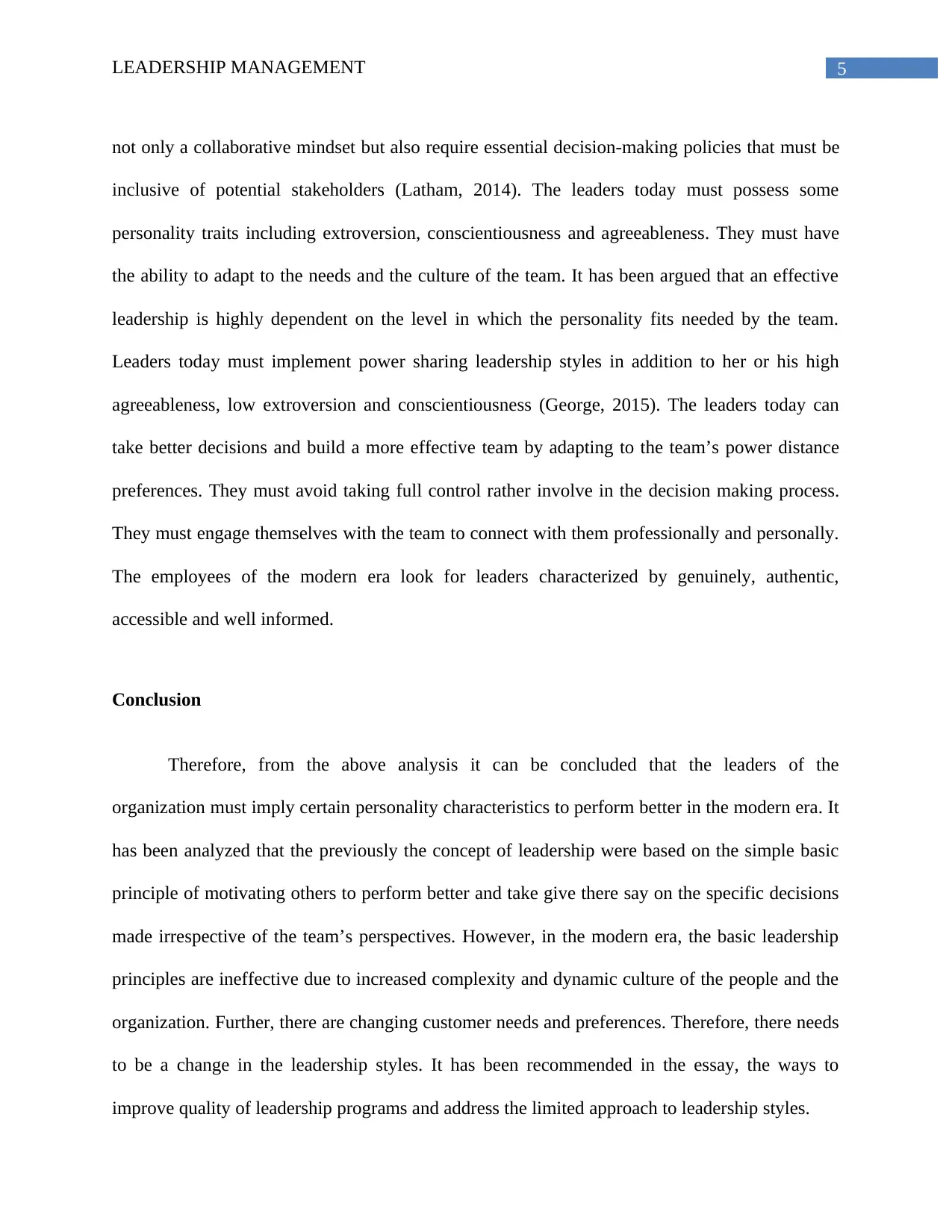
5LEADERSHIP MANAGEMENT
not only a collaborative mindset but also require essential decision-making policies that must be
inclusive of potential stakeholders (Latham, 2014). The leaders today must possess some
personality traits including extroversion, conscientiousness and agreeableness. They must have
the ability to adapt to the needs and the culture of the team. It has been argued that an effective
leadership is highly dependent on the level in which the personality fits needed by the team.
Leaders today must implement power sharing leadership styles in addition to her or his high
agreeableness, low extroversion and conscientiousness (George, 2015). The leaders today can
take better decisions and build a more effective team by adapting to the team’s power distance
preferences. They must avoid taking full control rather involve in the decision making process.
They must engage themselves with the team to connect with them professionally and personally.
The employees of the modern era look for leaders characterized by genuinely, authentic,
accessible and well informed.
Conclusion
Therefore, from the above analysis it can be concluded that the leaders of the
organization must imply certain personality characteristics to perform better in the modern era. It
has been analyzed that the previously the concept of leadership were based on the simple basic
principle of motivating others to perform better and take give there say on the specific decisions
made irrespective of the team’s perspectives. However, in the modern era, the basic leadership
principles are ineffective due to increased complexity and dynamic culture of the people and the
organization. Further, there are changing customer needs and preferences. Therefore, there needs
to be a change in the leadership styles. It has been recommended in the essay, the ways to
improve quality of leadership programs and address the limited approach to leadership styles.
not only a collaborative mindset but also require essential decision-making policies that must be
inclusive of potential stakeholders (Latham, 2014). The leaders today must possess some
personality traits including extroversion, conscientiousness and agreeableness. They must have
the ability to adapt to the needs and the culture of the team. It has been argued that an effective
leadership is highly dependent on the level in which the personality fits needed by the team.
Leaders today must implement power sharing leadership styles in addition to her or his high
agreeableness, low extroversion and conscientiousness (George, 2015). The leaders today can
take better decisions and build a more effective team by adapting to the team’s power distance
preferences. They must avoid taking full control rather involve in the decision making process.
They must engage themselves with the team to connect with them professionally and personally.
The employees of the modern era look for leaders characterized by genuinely, authentic,
accessible and well informed.
Conclusion
Therefore, from the above analysis it can be concluded that the leaders of the
organization must imply certain personality characteristics to perform better in the modern era. It
has been analyzed that the previously the concept of leadership were based on the simple basic
principle of motivating others to perform better and take give there say on the specific decisions
made irrespective of the team’s perspectives. However, in the modern era, the basic leadership
principles are ineffective due to increased complexity and dynamic culture of the people and the
organization. Further, there are changing customer needs and preferences. Therefore, there needs
to be a change in the leadership styles. It has been recommended in the essay, the ways to
improve quality of leadership programs and address the limited approach to leadership styles.
⊘ This is a preview!⊘
Do you want full access?
Subscribe today to unlock all pages.

Trusted by 1+ million students worldwide
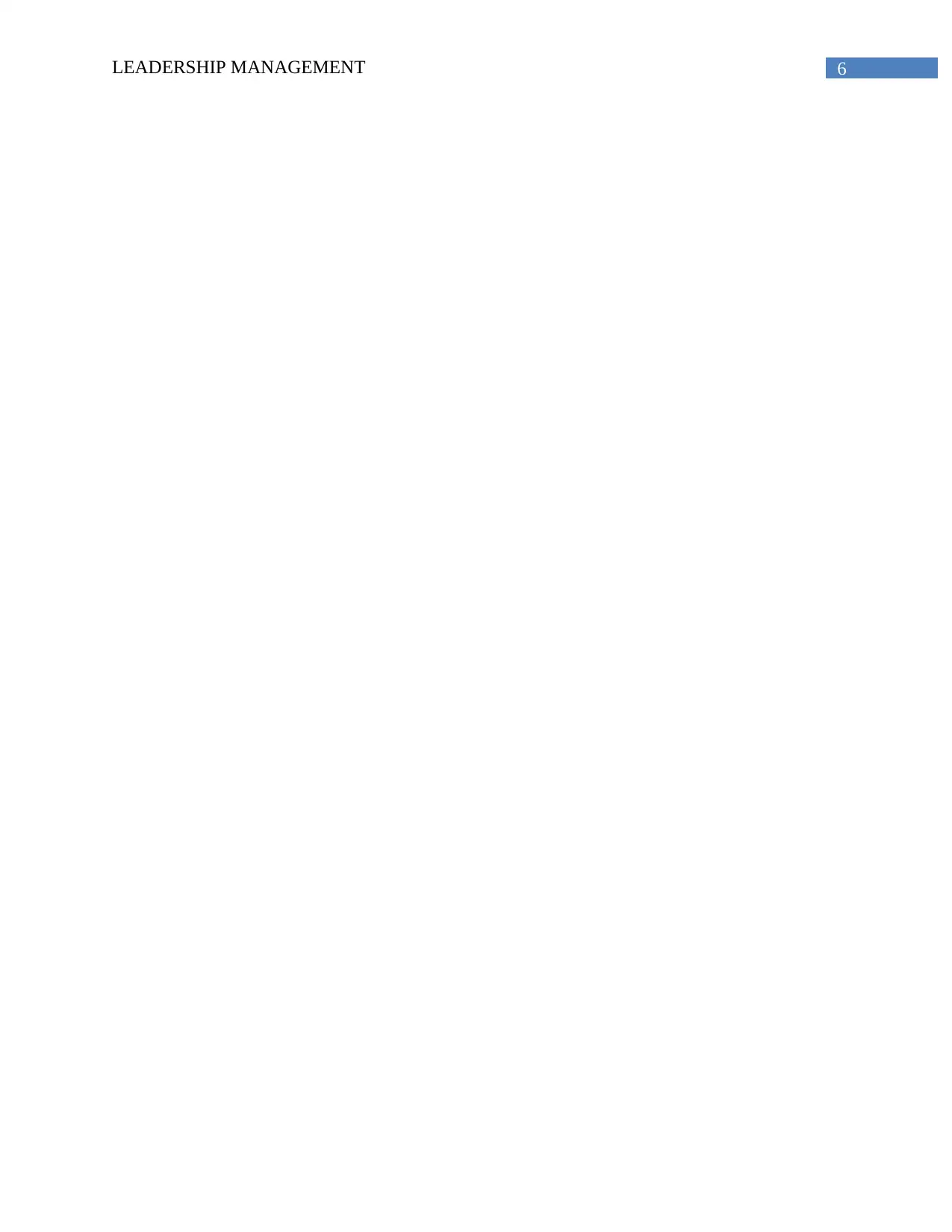
6LEADERSHIP MANAGEMENT
Paraphrase This Document
Need a fresh take? Get an instant paraphrase of this document with our AI Paraphraser
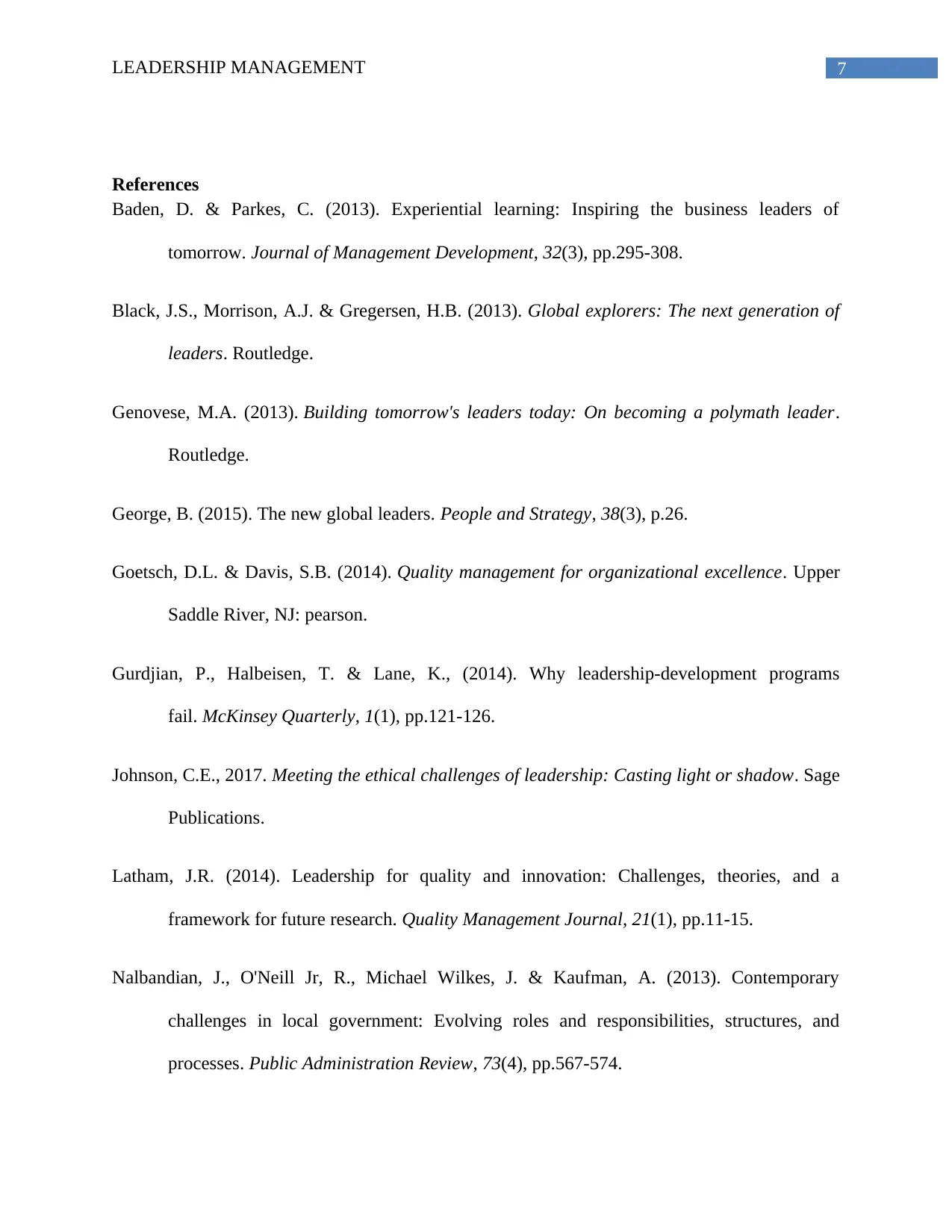
7LEADERSHIP MANAGEMENT
References
Baden, D. & Parkes, C. (2013). Experiential learning: Inspiring the business leaders of
tomorrow. Journal of Management Development, 32(3), pp.295-308.
Black, J.S., Morrison, A.J. & Gregersen, H.B. (2013). Global explorers: The next generation of
leaders. Routledge.
Genovese, M.A. (2013). Building tomorrow's leaders today: On becoming a polymath leader.
Routledge.
George, B. (2015). The new global leaders. People and Strategy, 38(3), p.26.
Goetsch, D.L. & Davis, S.B. (2014). Quality management for organizational excellence. Upper
Saddle River, NJ: pearson.
Gurdjian, P., Halbeisen, T. & Lane, K., (2014). Why leadership-development programs
fail. McKinsey Quarterly, 1(1), pp.121-126.
Johnson, C.E., 2017. Meeting the ethical challenges of leadership: Casting light or shadow. Sage
Publications.
Latham, J.R. (2014). Leadership for quality and innovation: Challenges, theories, and a
framework for future research. Quality Management Journal, 21(1), pp.11-15.
Nalbandian, J., O'Neill Jr, R., Michael Wilkes, J. & Kaufman, A. (2013). Contemporary
challenges in local government: Evolving roles and responsibilities, structures, and
processes. Public Administration Review, 73(4), pp.567-574.
References
Baden, D. & Parkes, C. (2013). Experiential learning: Inspiring the business leaders of
tomorrow. Journal of Management Development, 32(3), pp.295-308.
Black, J.S., Morrison, A.J. & Gregersen, H.B. (2013). Global explorers: The next generation of
leaders. Routledge.
Genovese, M.A. (2013). Building tomorrow's leaders today: On becoming a polymath leader.
Routledge.
George, B. (2015). The new global leaders. People and Strategy, 38(3), p.26.
Goetsch, D.L. & Davis, S.B. (2014). Quality management for organizational excellence. Upper
Saddle River, NJ: pearson.
Gurdjian, P., Halbeisen, T. & Lane, K., (2014). Why leadership-development programs
fail. McKinsey Quarterly, 1(1), pp.121-126.
Johnson, C.E., 2017. Meeting the ethical challenges of leadership: Casting light or shadow. Sage
Publications.
Latham, J.R. (2014). Leadership for quality and innovation: Challenges, theories, and a
framework for future research. Quality Management Journal, 21(1), pp.11-15.
Nalbandian, J., O'Neill Jr, R., Michael Wilkes, J. & Kaufman, A. (2013). Contemporary
challenges in local government: Evolving roles and responsibilities, structures, and
processes. Public Administration Review, 73(4), pp.567-574.
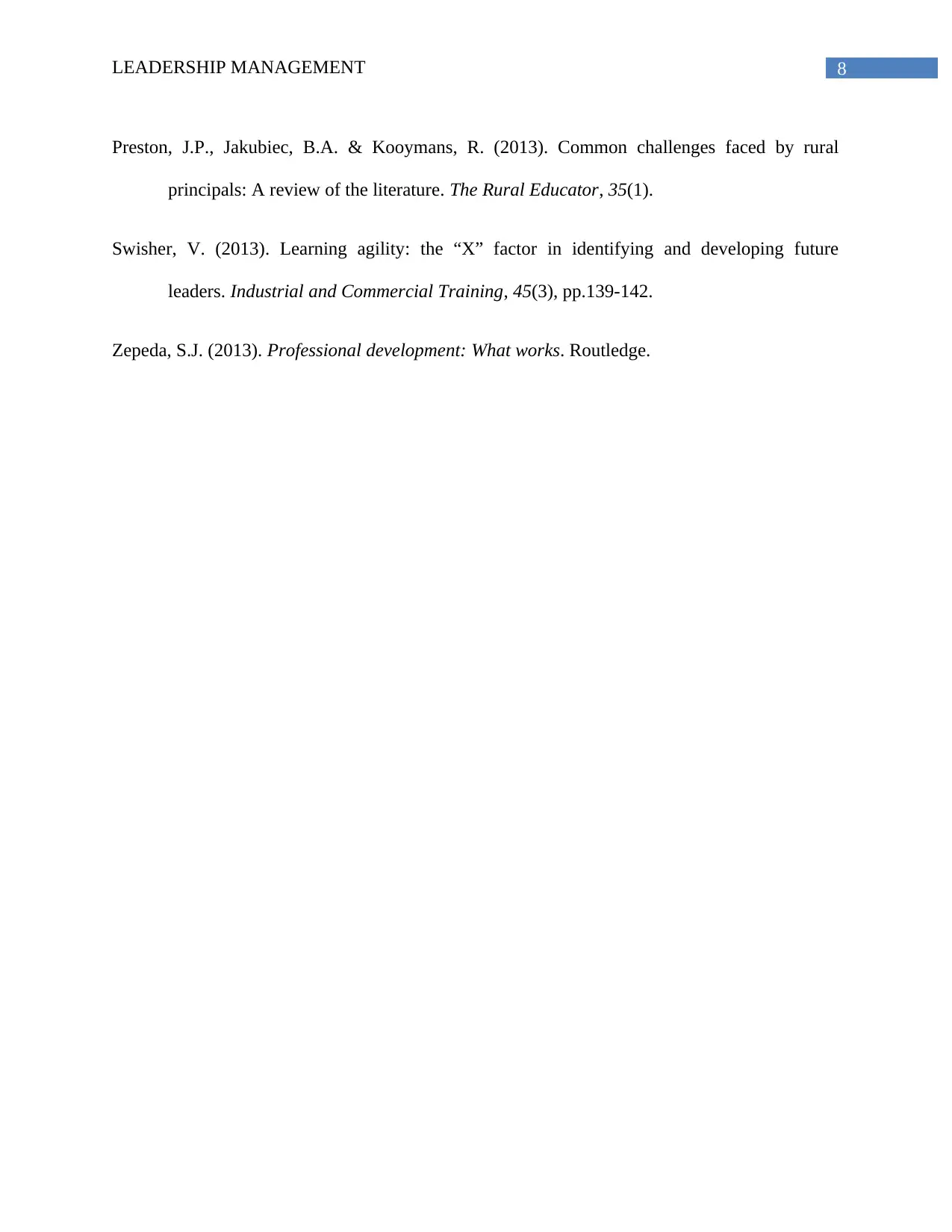
8LEADERSHIP MANAGEMENT
Preston, J.P., Jakubiec, B.A. & Kooymans, R. (2013). Common challenges faced by rural
principals: A review of the literature. The Rural Educator, 35(1).
Swisher, V. (2013). Learning agility: the “X” factor in identifying and developing future
leaders. Industrial and Commercial Training, 45(3), pp.139-142.
Zepeda, S.J. (2013). Professional development: What works. Routledge.
Preston, J.P., Jakubiec, B.A. & Kooymans, R. (2013). Common challenges faced by rural
principals: A review of the literature. The Rural Educator, 35(1).
Swisher, V. (2013). Learning agility: the “X” factor in identifying and developing future
leaders. Industrial and Commercial Training, 45(3), pp.139-142.
Zepeda, S.J. (2013). Professional development: What works. Routledge.
⊘ This is a preview!⊘
Do you want full access?
Subscribe today to unlock all pages.

Trusted by 1+ million students worldwide
1 out of 9
Related Documents
Your All-in-One AI-Powered Toolkit for Academic Success.
+13062052269
info@desklib.com
Available 24*7 on WhatsApp / Email
![[object Object]](/_next/static/media/star-bottom.7253800d.svg)
Unlock your academic potential
Copyright © 2020–2025 A2Z Services. All Rights Reserved. Developed and managed by ZUCOL.





